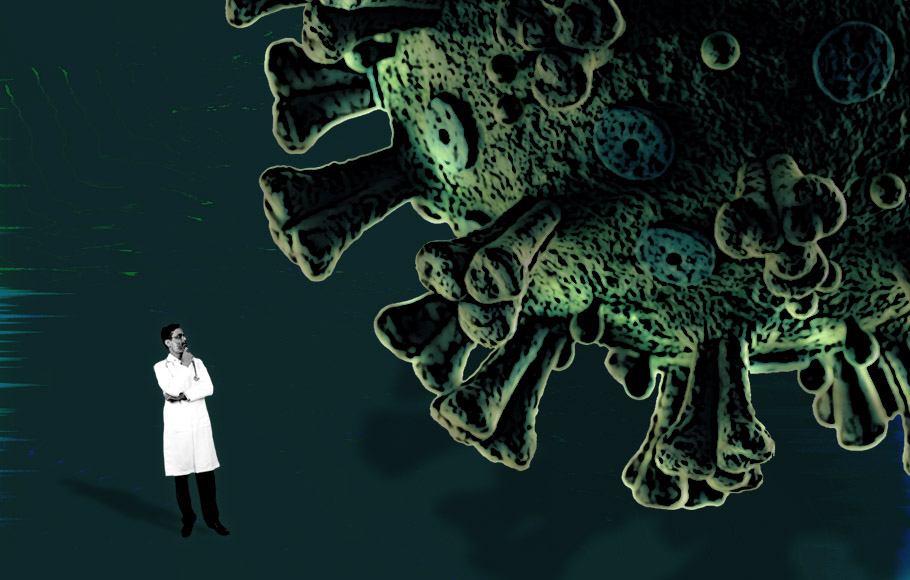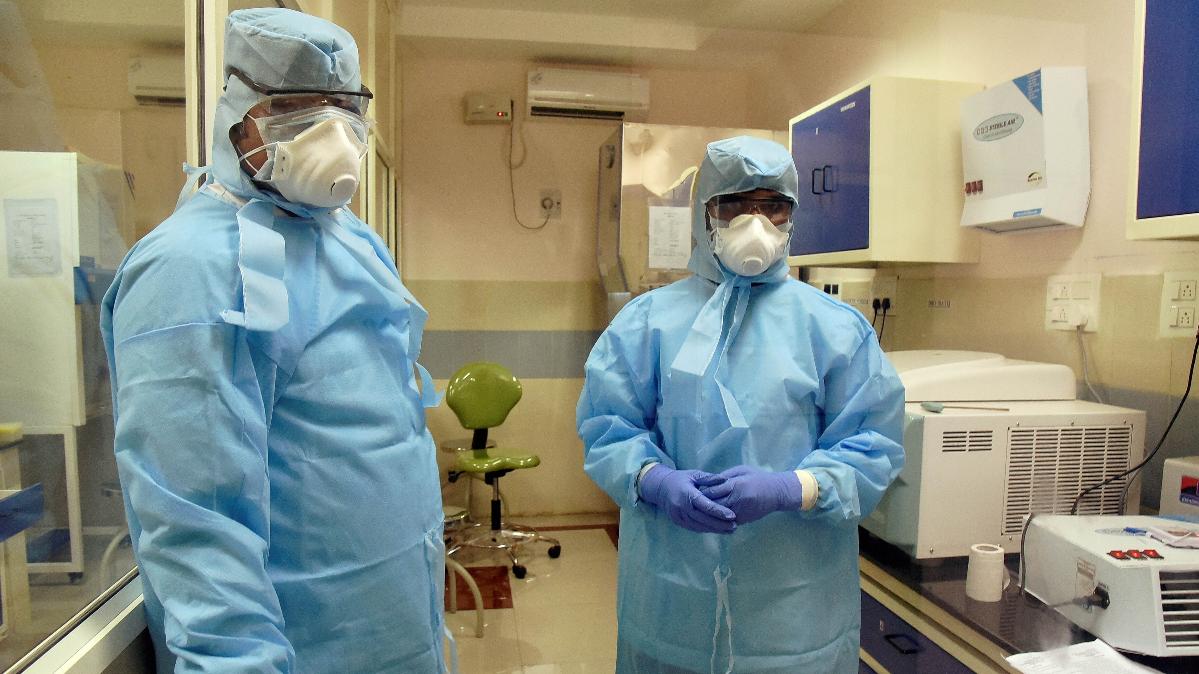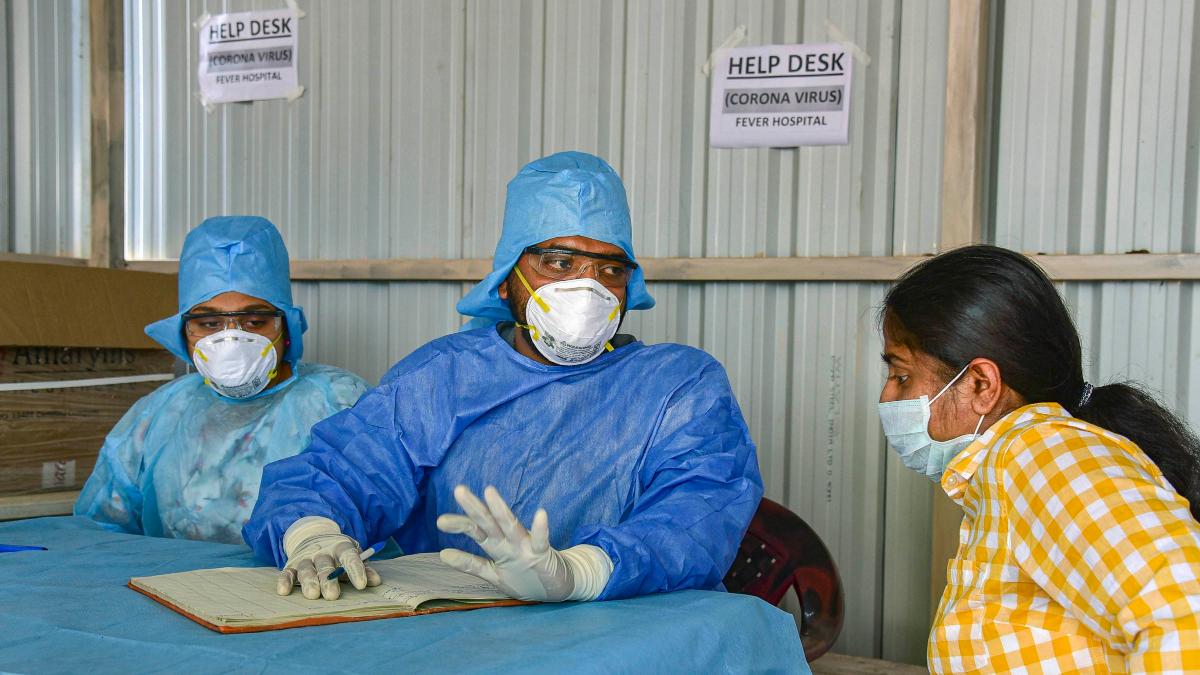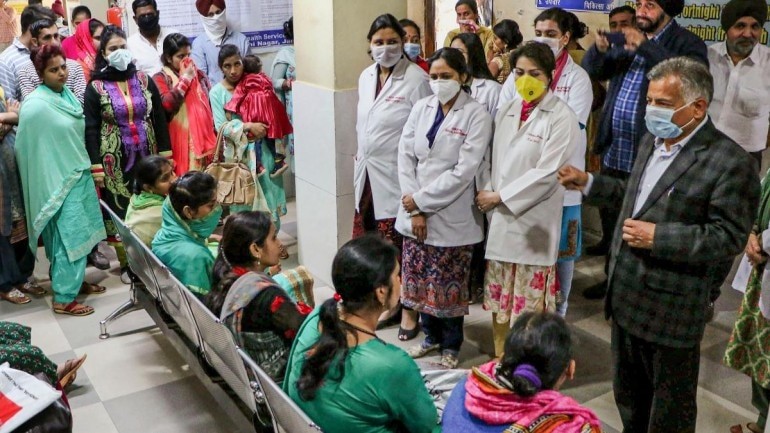
- Home
- News
- Analysis
- States
- Perspective
- Videos
- Education
- Entertainment
- Elections
- World Cup 2023
- Features
- Health
- Business
- Series
- Economy Series
- Earth Day
- Kashmir’s Frozen Turbulence
- India@75
- The legend of Ramjanmabhoomi
- Liberalisation@30
- How to tame a dragon
- Celebrating biodiversity
- Farm Matters
- 50 days of solitude
- Bringing Migrants Home
- Budget 2020
- Jharkhand Votes
- The Federal Investigates
- The Federal Impact
- Vanishing Sand
- Gandhi @ 150
- Andhra Today
- Field report
- Operation Gulmarg
- Pandemic @1 Mn in India
- The Federal Year-End
- The Zero Year
- Premium
- Science
- Brand studio
- Home
- NewsNews
- Analysis
- StatesStates
- PerspectivePerspective
- VideosVideos
- Entertainment
- ElectionsElections
- Sports
- Loading...
Sports - Features
- BusinessBusiness
- Premium
- Loading...
Premium

Doctors, the soldiers in the war against COVID-19

By the end of March, Anand (name changed) would have completed his graduation in medicine (MBBS). But in the middle of the month, he and his batchmates at Thanjavur Medical College Hospital in Tamil Nadu received a message that thrust them into the frontline of a crisis. “We were told that we will be on a month-long duty till April 28 in the COVID-19 ward,” he says. The novel coronavirus...
By the end of March, Anand (name changed) would have completed his graduation in medicine (MBBS). But in the middle of the month, he and his batchmates at Thanjavur Medical College Hospital in Tamil Nadu received a message that thrust them into the frontline of a crisis.
“We were told that we will be on a month-long duty till April 28 in the COVID-19 ward,” he says.
The novel coronavirus — that appeared in Wuhan, China, at the beginning of December 2019 — had spread globally by then. In India—with an under-resourced healthcare system — at least 250 million of the 1.33 billion population were predicted to be affected.
Even as containment measures began in some states and Prime Minister Narendra Modi was set to announce a 21-day nationwide lockdown, all hands were needed on the deck to deal with the outbreak.
For Anand, who is the first from his village near Thiruthuraipoondi in Thiruvarur district to pursue medicine, the pandemic had all the signs of an emergency that was not going to be over any time soon.
“I have finished my duty at the observation ward and I am on quarantine for the next seven days, after which I will return to another shift till the end of the month,” he says.
Juniors like him get to work either in the isolation or observation wards. While those on isolation duty go on self-quarantine for 14 days after working for seven days, others on 5-day observation duty need seven days’ quarantine.
Anand’s latest experience has changed his outlook towards his profession. “These few days have made me realise that if I have to serve people as a doctor, I have to work in the public sector. It’s mostly government medical colleges and hospitals in the country that are fighting the pandemic,” he adds.
Unlike Anand, for Arul Raja (name changed), a senior doctor in a Kanniyakumari hospital, this isn’t the first time a public health crisis is unfolding in front of his eyes. He had seen the 2004 tsunami.
“Hundreds of people were brought to the hospital then. Some dead and rotting for hours. Others, waking up to haunting memories of the killer waves. For days, I could only hear sobs and screams,” he tells The Federal.
But COVID-19, he says, has changed the definition of the term uncertainty for doctors. “I see fear and misery among patients and doctors alike.”
A specialist in general medicine, Raja now heads a team of doctors who are treating COVID-19 cases. “I am not an expert in infectious diseases but the call of duty demands that I respond. With just a few years left to retire, here I am learning from the scratch about treatment for COVID-19 and how to be ahead of the disease,” he says.

Dealing with patients
Having 15 COVID-19 patients in his hospital means a third of the healthcare staff deployed on COVID duty, another one-third given rest, and the remaining put on general duty. Raja, however, is confident that his team is prepared to accommodate more patients, if the need arises.
“I see fear of the unknown among patients. While some fear anyone who contracts the virus will eventually die, some patients are extremely impatient and irritable.” But he claims the doctors, nurses and other hospital staff have been trained well enough to handle all patients with empathy and patience.
“They have been trained to allay the patients’ fears and make them cooperate with the treatment. If patients don’t trust us or the treatment, anything we do will be rendered insufficient,” he explains.
And no one knows better than Raja how bad it feels when the treatment fails to work. The hospital where he works has already seen two COVID-19 deaths — a 40-year-old man and a 60-year-old woman. “Despite best efforts when patients die, it can be a setback to our morale.”
Self-care
With hospitals across cities reporting a shortage of personal protective equipment (PPE) for health staff, the pandemic has in the recent past seen many doctors raising an alarm. A doctor in Haryana had posted on Twitter to send the equipment to her grave when it arrives.
Already burdened with a dismal doctor-patient ratio of 1:1,456, health experts fear it will not be possible for India to flatten the COVID-19 curve if the PPE shortage continues.

Raja, however, says that convincing doctors to serve during the pandemic needs more than just PPEs.
For instance, two doctors who were trained to treat patients infected with coronavirus fled from an Indian Navy hospital in Maharashtra on the pretext of parking their cars after they were assigned to report to their superiors.
“We have been arranging training and counselling for the junior doctors who are on duty for longer hours. They have a fear of getting infected, but we need to assure them. With adequate protective gear and adhering to other precautions, they are not going to be affected,” Raja says.
Initially, some had even refused to treat the patients, he adds. “But after repeated counselling sessions, they are keen on treating the patients with confidence. The challenge to keep the confidence level high is a big one.”
However, having observed the crisis from close quarters, Anand claims the actual burden of treating the COVID-19 patients falls on the post-graduate students and those on Compulsory Rotatory Residential Internship (CRRI), and not the department heads or dean. “They are the ones in constant danger of exposure to the virus.”
There are other occupational hazards. Like, wearing PPEs for long hours at a stretch without food or toilet breaks.
That’s precisely why Dr Aravind R, head of infectious diseases in Thiruvananthapuram Medical College, says PPE alone doesn’t solve the problem. “One cannot be in it throughout duty hours.”
To deal with this issue, his hospital has devised an arrangement wherein the doctors and healthcare staff treating COVID-19 patients would be in PPE for about four hours a day only, and the rest of the time, out of it, during which they would look into the case sheets from outside the wards or ICU.
Another attack on Doctor!!
Dr Geeta (Renal transplant Surgeon)
Stanford hospital Ranchi. Ex Senior Resident from AIIMS, NEW DELHI attacked by unknown people while going for duty.
How long we will wait? @AmitShah @drharshvardhan
Urgent need of central protection act.@ANI pic.twitter.com/G0OwE1D8yk— RDAAIIMS (@AIIMSRDA) April 17, 2020
Kerala, which was the first to report COVID-19 cases in the country, has been at the forefront of the fight against the disease, and even in securing the lives of doctors and healthcare workers, having learnt from the 2018 Nipah virus experience.
“Our policies have been focused on cutting these infections. If the doctors or nurses get infected by the disease, it would be extremely demoralising for the team treating patients,” Dr Aravind says.
Family and society
Before he was put on COVID-19 duty almost 100 days ago, the first thing Dr Aravind did was to send his elderly parents to his sister’s house. When the news of the outbreak in the Middle East reached them around February, they realised that they would be in for a long haul, as a majority of Keralites have business and employment interests there.
Anand claims that he doesn’t fear contracting the virus. “But my folks are worried,” he says with a laugh. “On other days, they would barely talk to me, but after I began duty at the COVID-19 ward, I get calls every day. I am glad I am not putting them at risk, and am staying back in my hostel.”
But many doctors, who unlike Anand or Aravind, live in rented accommodation, had to deal with hostile landlords. In Delhi, doctors working at AIIMS were evicted from their apartments by their landlords and the matter had to be taken up by the Home Ministry and police. In other cases, according to some reports, landlords and neighbours became hostile to the doctors, forcing some to stay back at hospitals or find refuge in friends’ homes.
@PMOIndia @KTRTRS, respected sir… This is what happened yesterday night to my fellow doctors, after completing there duties at hyderabad.. Even after showing there ids they didn't listen and beaten them with lathi as if they r criminals… pic.twitter.com/06wdJKIBfb
— Dr.Naresh kumar (@medico_naresh16) March 24, 2020
Doctors have been subjected to harassment from various quarters. A young doctor returning home from her night duty was abused and slapped by Telangana police for violating the lockdown, soon after it was imposed on March 24.
The stigma doesn’t go even after death, as some healthcare personnel found out in Chennai when they took bodies of two doctors who had died of COVID-19 for cremation. Local residents, fearing the spread of the virus, protested and even threw stones at the ambulance.
Raja says the government should create more awareness. “When the fear of infections is high among doctors, the public too will be scared and this is a new pandemic. The public must be assured that doctors take adequate care to ensure that they are not carriers of infection,” he says.
Some others feel even the government is not backing them up adequately. The Tamil Nadu Government Doctors’ Association (TNGDA) demanded adequate security from the government, saying government doctors are risking their own lives with the available poor quality/inadequate protective gears in treating patients.
It’s not just this. Many are upset over the COVID-19 accident insurance scheme for healthcare workers. The Ministry of Health and Family Welfare had announced that healthcare professionals treating COVID-19 patients would be covered under an insurance plan of ₹50 lakh. But it turned out that the scheme would only cover for the loss of life and not the expenses incurred on treatment or during quarantine.
Last week, an ortho surgeon, Dr Lakshminarayan Reddy, succumbed to COVID 19 at the Apollo Hospitals in Chennai. He had contracted the disease from a patient whom he had attended to at his clinic in Nellore, Andhra Pradesh. However, there is not much clarity regarding the compensation to his family. A source from the Tamil Nadu Health Systems Project that handles insurance tells The Federal that it would be too early to comment. “The case is yet to be assessed and it would be too early to comment. The treatment for healthcare workers infected during duty are covered free of cost.”
It is this lack of clarity that has irked doctors. What has added to healthcare professionals’ grouses is the ‘gag order’ on them from speaking to the media both at the state and national level (a reason why all doctors The Federal approached spoke on condition of anonymity).

Although the Union health ministry denies any such censorship on doctors and other health professionals, it has been suggested that the frontline workers should take it up with the authorities to get their grievances addressed instead of speaking publicly or on social media. Many of them have allegedly faced severe reprimand and even threats of dismissals for highlighting the lack of PPE.
Hydroxychloroquine debate
While the use of antimalarial drug hydroxychloroquine as a form of protection against COVID-19 has been recommended by the Indian Council of Medical Research (ICMR) for healthcare workers, there is a lot of debate surrounding it, even among doctors. A doctor from Assam died of cardiac arrest after taking two doses of HCQ days before the state reported its first case.
Anand, who took the medicine after ICMR recommended it, has his reservations. “I took two doses of the medicine as suggested. I became a little wary about continuing the medicine after reading about its side effects — like irregular heartbeat and blindness. So, I have stopped taking the medicine altogether. Hopefully, my age is an advantage, cutting the percentage of risk.”
N Kumarasamy, chief and director, Infectious Diseases Medical Centre, Voluntary Health Services, Chennai, says the claims of its side-effects like blindness, fibrillation of the heart, etc. may not be true. “There doesn’t seem to be an antiviral effect. Studies are still underway to find the effectiveness of the drug (against COVID-19).”
What the future holds
As many countries are hoping to flatten the curve sooner than later, doctors are keeping their fingers crossed.
Anand believes that the pandemic is only the beginning of many such outbreaks. “At least for the next six months, we have to be wary of it. Other countries like China have seen a relapse in infections and that can actually be a warning for us in India too — to not be complacent about cured and discharged cases.”
Till the whole pandemic subsides, doctors will be on their toes.
“I cannot afford to (go on quarantine) because there will be challenging cases that will need my intervention,” says Aravind, adding that the junior doctors are sent on 14-day quarantine after seven-day duty on rotation.
Raja agrees. “There is nothing called after duty hours at the moment for us. Even after I return home, I am always on my toes to respond to any emergency calls.”
(This story is part of a series on frontline personnel in the fight against COVID-19. You can read the other stories here)

